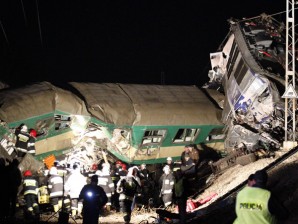14 killed, 60 injured in Polish train crash
WARSAW – Fourteen people were confirmed dead and sixty injured in a head-on train crash in Szczekociny, southern Poland, late Saturday as rescue workers raced overnight to pull passengers from the wreckage.

Rescuers work late on March 3, 2012 at the scene where two trains crashed head-on in Szczekociny, southern Poland, killing several people and injuring more than 60 passengers. The head-on collision took place at 2100 hrs local time (2000 GMT) between two trains travelling on the same track--one was en route to the southern city of Krakow from the capital Warsaw, while the other was travelling to the capital from the south-eastern city of Przemysl. AFP PHOTO
“The death toll in this huge train catastrophe has risen to 14,” Poland’s Interior Minister Jacek Cichocki said, speaking at the crash site.
“It appears there are no more conscious people in the wagons,” Cichocki told reporters early Sunday.
Sixty people were hospitalized with about half reported to be in a serious condition, rescue officials said.
Some 350 passengers were travelling on board two trains which collided head-on at 9:00 pm (2000 GMT) as they were travelling on the same track, according to Poland’s PKP railways.
One train was en route to the southern city of Krakow from the capital Warsaw, while the other was travelling to the capital from the south-eastern city of Przemysl.
Article continues after this advertisementAn investigation was launched Sunday morning into the reasons behind the fatal crash as the rescue operations continued in the early hours.
Article continues after this advertisementImages of the wreckage broadcast by the TVN24 commercial news channel showed mangled wreckage with reports indicating three carriages had jumped the tracks along with the locomotives from both trains.
“We heard a deafening noise and we were hurled out of our seats,” an unnamed survivor told the PAP Polish news agency. “We saw crushed bodies pinned beneath seats and we saw parts of
bodies inside and outside the train wagons,” the survivor said.
“It was terrifying. The scale of destruction is huge,” one of the first firemen on the scene told the PAP.
Another survivor told the TVN24 news channel of dead bodies as well as people still alive but pinned down under twisted metal.
Fireman Grzegorz Widawski described the conditions at the crash site as “very challenging.”
“The wagons are in very bad shape and it’s difficult to get to the people trapped inside,” he told the PAP.
A total 450 firemen and 100 policemen were involved in the rescue efforts, emergency response authorities said.
Poland’s Prime Minister Donald Tusk and Transport Minister Slawomir Nowak were also expected at the crash site overnight, according to a government statement.
Saturday’s accident is the worst rail catastrophe in Poland since 1990, when 16 people were killed in a collision between two trains in the Warsaw suburb of Ursus.
The country’s most deadly train wreck occurred in 1980 in Otoczyn, near the northern city of Torun when 67 people died and 62 were injured in a collision between a passenger and a freight train.
Originally posted at 08:46 am | Sunday, March 4, 2012